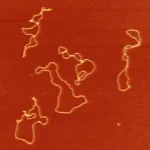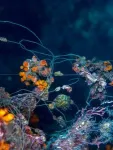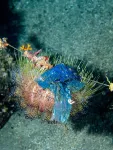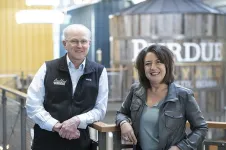(Press-News.org) Like its viral cousins, a somewhat parasitic DNA sequence called a retrotransposon has been found borrowing the cell’s own machinery to achieve its goals.
In a new work appearing online Wednesday in the journal Nature, a Duke University team has determined that retrotransposons hijack a little-known piece of the cell’s DNA repair function to close themselves into a ring-like shape and then create a matching double strand.
The finding upends 40 years of conventional wisdom saying these rings were just a useless by-product of bad gene copying. It may also offer new insights into cancer, viral infections and immune responses.
Retrotransposons are segments of DNA around 7,000 letters long that copy and paste themselves into different parts of the genomes of both plants and animals. By doing this, they play a role in rewriting DNA and regulating how the cell uses its genes. Retrotransposons are believed to be behind a lot of the variation and innovation in genes that drives evolution, and are inherited from both parents.
Many studies have suggested that these rings of DNA outside the chromosomes are somehow involved in the development and progression of cancer in part because they are known to harbor cancer-driving oncogenes within their DNA sequences. The retrovirus HIV, which causes AIDS, is also known to form circular DNA.
“I think these elements are the source of genome dynamics, for animal evolution and even to affect our daily lives,” said Zhao Zhang (ZZ), an assistant professor of pharmacology and cancer biology and a Duke Science & Technology scholar. “But we are still in the process of appreciating their function.”
Retrotransposons are quite common – they make up about 40% of the human genome, and more than 75% of the maize genome -- but how and where they copy themselves has always been a bit murky.
Zhang holds up a thick textbook on retroviruses that he consulted for this study. The books say the ring-like sequences are “created by recombining the two ends of linear DNA, and are just a dead end, a by-product of failed replication,” he said.
In earlier work with fruit fly eggs, Zhang’s team had established that inherited retrotransposons use the ‘nurse cells’ which support the egg as factories to manufacture many copies of themselves that are then distributed throughout the genome in the fly’s developing egg. This model system allowed the researchers to zoom in still further to learn more about retrotransposons.
In the latest work, they found unexpectedly that most newly added retrotransposons were in this circular form rather than being integrated into the host’s genome. Then they ran a series of experiments knocking out the cell’s DNA repair mechanisms one at a time to figure out how and where the circles are being formed.
The answer: A little-studied DNA repair mechanism called alternative end-joining DNA repair, or alt-EJ for short, which repairs doubles-stranded breaks. The retrotransposon sequences were using this part of the host’s repair machinery to sew the ends of their single-stranded DNA together and then using its DNA synthase to create a matching double-strand. For good measure, the researchers confirmed that this is also the process within human cells.
So retrotransposons aren’t a sloppy accident; they’re actually hijacking a little bit of the cell’s machinery to manufacture more of themselves, just like viruses do.
“Our discovery actually overturns the textbook model,” Zhang said. “We showed that the recombination event proposed by the textbook is not important to forming rings,” Zhang said. “Instead, it’s the alt-EJ pathway driving circle production.”
“My lab currently is trying to test whether circular DNA can be an intermediate to make new genome insertions,” Zhang said. “We’re also testing whether circular DNA can be sensed by our immune system to trigger an immune response.”
“In the retroviral field and retrotransposon field, people think circular DNA is just a minor event, but our study is bringing circular DNA into the center stage,” Zhang said. “People should pay more attention to circular DNA.”
Funding for this study came from the National Cancer Institute (P01CA247773), National Institutes of Health (DP5 OD021355, R01 GM141018) and the Pew Biomedical Scholars Program.
CITATION: “Retrotransposons Hijack alt-EJ for DNA Replication and eccDNA Biogenesis, ” Fu Yang, Weijia Su, Oliver W. Chung, Lauren Tracy, Lu Wang, Dale A. Ramsden, ZZ Zhao Zhang. Nature, July 12, 2023. DOI: 10.1038/s41586-023-06327-7
END
DNA element with a murky past is borrowing cell’s repair machinery
Circular DNA, thought to be an accidental byproduct, is borrowing the cell’s DNA repair mechanisms to copy itself
2023-07-12
ELSE PRESS RELEASES FROM THIS DATE:
Plastic pollution on coral reefs increases with depth and mostly comes from fishing activities, Nature study finds
2023-07-12
SAN FRANCISCO, CA (July 12, 2023) — In a paper published today in Nature, researchers from the California Academy of Sciences, University of São Paulo, University of Oxford, University of Exeter, and other collaborators reveal the extent of plastic pollution on coral reefs, finding that debris increases with depth, largely stems from fishing activities, and is correlated with proximity to marine protected areas.
Through underwater visual surveys spanning more than two dozen locations across the Indian, Pacific, and Atlantic ...
Mast cells as a sensor: Enigmatic immune cells help to avoid harmful allergens
2023-07-12
The function of mast cells, which are part of the immune system, is still a mystery. Scientists at the German Cancer Research Center (DKFZ) have now shown in mice: mast cells function as a sensor that signals the animals to avoid antigens, including harmful allergens, and thereby protect themselves from health-threatening inflammatory reactions. The findings were published in the journal Nature.
Mast cells are found primarily in tissues that separate the outside and inside worlds of the body, such ...
Detailed map of the heart provides new insights into cardiac health and disease
2023-07-12
In a new study, published today (12 July) in Nature, researchers have produced the most detailed and comprehensive human Heart Cell Atlas to date, including the specialised tissue of the cardiac conduction system - where the heartbeat originates.
The multi-centre team is led by the Wellcome Sanger Institute and the National Heart and Lung Institute at Imperial College London, and has also presented a new drug-repurposing computational tool called Drug2cell, which can provide insights into the effects of drugs on heart rate.
This study is part of the international Human Cell Atlas* ...
Second year of COVID pandemic brought spike in child mental health visits to ED
2023-07-12
The number of young people in the United States visiting hospital emergency departments for mental health crises increased sharply during the second year of the COVID-19 pandemic, according to a study led by researchers from the Department of Health Care Policy in the Blavatnik Institute at Harvard Medical School. The findings are published Jul 12 in JAMA Psychiatry.
These results come amidst growing national concern about a crisis in youth mental health and provide important new details about how young people with mental health problems such as self-harm ...
Global study details microplastics contamination in lakes and reservoirs
2023-07-12
LAWRENCE, Kan. — Around 14 million tons of plastic end up in the ocean every year. But that is not the only water source where plastic represents a significant intrusion.
“We found microplastics in every lake we sampled,” said Ted Harris, associate research professor for the Kansas Biological Survey & Center for Ecological Research at the University of Kansas.
“Some of these lakes you think of as clear, beautiful vacation spots. But we discovered such places to be perfect examples of the link between plastics and humans.”
Harris ...
A foundation that fits just right gives superconducting nickelates a boost
2023-07-12
Researchers at the Department of Energy’s SLAC National Accelerator Laboratory and Stanford University say they’ve found a way to make thin films of an exciting new nickel oxide superconductor that are free of extended defects.
Not only does this improve the material’s ability to conduct electricity with no loss, they said, but it also allows them to discover its true nature and properties, both in and out of the superconducting state, for the first time.
Their first look at a superconducting nickel oxide, or nickelate, that does ...
New study using human fibroid cells supports use of green tea compound as treatment for uterine fibroids
2023-07-12
In a pre-clinical, proof-of-concept study from Johns Hopkins Medicine, researchers found that epigallocatechin gallate (EGCG), a green tea compound with powerful antioxidant properties, could be promising for both treating and preventing uterine fibroids. Results of the study, first posted online May 25 in Scientific Reports, add to growing evidence that EGCG may reduce fibroid cell growth. The study was specifically designed to identify the biochemical mechanisms responsible for EGCG action in fibroid cells.
The investigators emphasize that their study involves human fibroid cells grown in the laboratory and treated with EGCG extract to explore the possibility of oral EGCG supplementation ...
The good advice that could lift people out of poverty
2023-07-12
Providing access to housing, debt, and benefit advice within food banks could help lift people out of poverty - according to a University of East Anglia study.
Researchers worked with Norwich Foodbank centres, part of the Trussell Trust, on a pilot project that saw representatives from Citizens Advice and Shelter posted within the service.
The ‘Making a Difference’ initiative meant that people forced to use a food bank were also able to access advice on a range of issues - from housing and debt to benefits.
It is now hoped that this scheme will be rolled out to foodbanks nationally.
Lead researcher Dr Sarah Hanson, from UEA’s School of ...
Amplified Sciences receives $400,000 NCI grant to improve early detection of pancreatic cancer
2023-07-12
WEST LAFAYETTE, Ind. – Health care providers and their patients could know with greater confidence whether pancreatic cysts are benign or potentially malignant, and if surgery is required to remove them, by using a new diagnostic test currently in development.
Amplified Sciences, a clinical-stage life sciences diagnostic company that licenses Purdue University innovations, has received a Phase I Small Business Innovation Research, or SBIR, grant of approximately $400,000 from the National Cancer Institute (NCI) to develop the test. The company focuses on accurately detecting and categorically assessing the risks of debilitating ...
Birmingham start-up awarded funding for technology that generates water out of air
2023-07-12
NovNat Tech Ltd, a visionary new company based in the Unit 9 incubator at the Birmingham Research Park, has secured funding from Innovate UK to develop a novel technology that can generate water out of air.
NovNat Tech is offering solutions to one of the most critical problems of today and the future, the global water scarcity crisis, and is developing a first of its kind ‘atmospheric water harvester’ to help address the global water shortage.
The harvest uses a proprietary material that has already been ...
LAST 30 PRESS RELEASES:
AI overestimates how smart people are, according to HSE economists
HSE researchers create genome-wide map of quadruplexes
Scientists boost cell "powerhouses" to burn more calories
Automatic label checking: The missing step in making reliable medical AI
Low daily alcohol intake linked to 50% heightened mouth cancer risk in India
American Meteorological Society announces Rick Spinrad as 2026 President-Elect
Biomass-based carbon capture spotlighted in newly released global climate webinar recording
Illuminating invisible nano pollutants: advanced bioimaging tracks the full journey of emerging nanoscale contaminants in living systems
How does age affect recovery from spinal cord injury?
Novel AI tool offers prognosis for patients with head and neck cancer
Fathers’ microplastic exposure tied to their children’s metabolic problems
Research validates laboratory model for studying high-grade serous ovarian cancer
SIR 2026 delivers transformative breakthroughs in minimally invasive medicine to improve patient care
Stem Cell Reports most downloaded papers of 2025 highlight the breadth and impact of stem cell research
Oxford-led study estimates NHS spends around 3% of its primary and secondary care budget on the health impacts of heat and cold in England
A researcher’s long quest leads to a smart composite breakthrough
Urban wild bees act as “microbial sensors” of city health.
New study finds where you live affects recovery after a hip fracture
Forecasting the impact of fully automated vehicle adoption on US road traffic injuries
Alcohol-related hospitalizations from 2016 to 2022
Semaglutide and hospitalizations in patients with obesity and established cardiovascular disease
Researchers ‘listen in’ to embryo-mother interactions during implantation using a culture system replicating the womb lining
How changing your diet could help save the world
How to make AI truly scalable and reliable for real-time traffic assignment?
Beyond fragmented markets: A new framework for efficient and stable ride-pooling
Can shape priors make road perception more reliable for autonomous driving?
AI tracks nearly 100 years of aging research, revealing key trends and gaps
Innovative techniques enable Italy’s first imaging of individual trapped atoms
KIER successfully develops Korea-made “calibration thermoelectric module” for measuring thermoelectric device performance
Diversifying US Midwest farming for stability and resilience
[Press-News.org] DNA element with a murky past is borrowing cell’s repair machineryCircular DNA, thought to be an accidental byproduct, is borrowing the cell’s DNA repair mechanisms to copy itself






